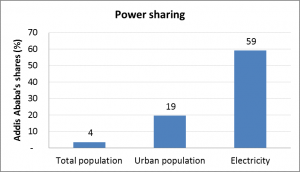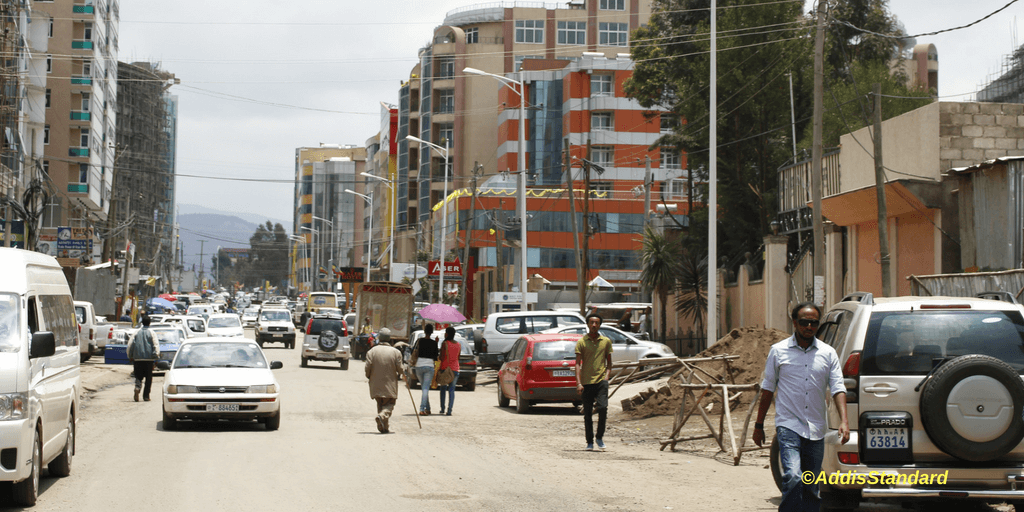Analysis: Addis Abeba: An Enigmatic City
Ayele Gelan, (PhD), special to Addis Standard
Addis Abeba, May 10/2018 – At its birth, Ethiopia’s capital city was given a romantic and beautiful name – Addis Abeba meaning New Flower. As time went by, however, Addis Abeba grew into an enigmatic city. To a foreigner, the city is a mysterious and exotic place, a vibrant cosmopolitan city that offers a unique blend of culture and cuisine, a good value for money with tourist spending. Ethiopians would find Addis Abeba a joyful place too but they have increasingly begun to recognize the charm they see in it is that of a prodigal daughter type. To begin with, Addis Abeba is rapidly becoming a place in which the majority of Ethiopians cannot afford to live.
Since the tragic and disastrous events surrounding the botched Addis master plan, infamously referred to by protesters as “master killer”, Addis Abeba has become more of a beast than a beauty in the minds of millions of Ethiopians. It may have sounded as if the city’s beautiful name was coined to mask its ugly functions in the country’s social and economic history in its later years.
But what has gone wrong with Addis Abeba’s functions in Ethiopia’s economy? In this piece I will attempt to answer these and related questions. I will confine my analysis mainly to the role of the city in Ethiopia’s economic development; specifically using urban economics as an analytical frame. I will then briefly touch on issues related to social and community cohesion as well as sustainable city development.
The setting
In order to explain Addis Abeba’s functions in Ethiopia’s economy, it is appropriate to briefly discuss the setting, the extent of Ethiopia’s urbanization. The rate of urbanization is often measured by expressing total urban population as a ratio of total population of that country. By this criterion, Ethiopia is one of the least urbanized countries in the world.
According to the Word Bank’s flagship publication, the World Development Indicator, about 20% of Ethiopia’s population lived in urban areas in 2016, ranking 248th out of 260 countries surveyed, according to that report. From Africa, only five countries fell below Ethiopia: South Sudan and Niger (19% each), Uganda and Malawi (16% each), and Burundi with 12%.
The health of overall urbanization or modernization of a developing economy is measured by the extent of structural transformation – a change in the structure and composition of the economy from predominantly rural and agricultural to urban and industrial. Only 9% of Ethiopia’s work force was employed in the industrial sector in 2016. Even this might be an overestimation in that Ethiopia’s industrial employment have been hugely inflated by the construction boom, due largely to the mushrooming mega public projects in recent decades.
In that case, it is appropriate to focus on manufacturing, which indicates the extent of substantive or real structural transformation. Between 2010 and 2016, the share of manufacturing in Ethiopia’s GDP was 4.2% on average. The corresponding average contribution during the six years preceding 1990 was 5%, that is to say a decline by 0.8% in the relative position of manufacturing in Ethiopia’s economy over the last three decades. This means the hype about Ethiopia’s economic growth miracles and transformations seems to have come to naught.
The rate of urbanization discussed above simply indicates the extent to which the structure of the economy and society is being transformed from traditional to modern, both in terms of residential places of the population (rural to urban) and structure of the economy (agricultural to industrial). With change in structure in the sectoral composition of the economy, the relative sizes of the two spatial dimensions (urban and rural) are expected to change over time – the former expanding the latter contracting.
Critically, the two components – the modern/urban/industrial and traditional/rural/agricultural – economies do not simply coexist but also they do interact in different markets, exchanging goods and services, also in labor markets through rural-urban migration. The latter becomes possible through improvements in agricultural productivity, which makes it possible to release labor for the modern industrial sector.
Lopsided
The role of Addis Abeba should be discussed in the context of the shallow structural transformation of the country – even the extremely low rate of urbanization is not accompanied with industrialization or manufacturing development to any real extent.
Now it is appropriate to focus the discussion on Addis Abeba itself; specifically, the city’s relative size and its functions. The functions of urban areas in energizing the national economy, specifically enhancing productivity in the rural and peripheral locations, would critically depend on the size and structure of the urban systems.
In a modernizing and urbanizing economy, urban systems are expected to follow a pyramid like cascading structure with the largest city in the center and the size and distribution of the rest of cities in the urban hierarchical system following a certain pattern. This is governed by what urban economists and geographers call Zipf’s law. According to this law, the population of the city on top, the mega city, is expected to be: about two times the population of the second largest city, and three times that of the third largest city, four times that of the fourth largest city, and so on. City rank size distributions in most countries may not exactly fit to this analytical frame but they do closely follow this pattern of distribution.
However, the rank and size structure of Ethiopia’s cities seem to defy Zipf’s Law. Ethiopia is a rare and special case. Addis Abeba dwarfs the rest of cities in Ethiopia to a baffling extent. The table here shows the extent of abnormality of Addis Abeba. In order to facilitate comparability, population data for all countries and cities presented in the table are obtained from the same source.
Ten African countries and five from the rest of the world are selected and then ranked according to the ratio of the largest to the second largest cities in each country.
Ethiopia comes on top, with the ratio of the population of Addis Abeba to Adama, Ethiopia’s second largest city, standing at a whopping 10.1 ratio. As noted earlier, this ratio is expected to be close to 2. Kigali and Dar Es Salam are the other two African countries that show a degree of abnormality but theirs come nowhere near that of Addis Abeba.
The Zipf ratios of most mega cities of the rest of African fall in the normal range. Similarly, ratios computed for other countries in the rest of the world even more so, except for London, whose population is about eight times that of Birmingham, UK’s second largest city. Even London’s ratio falls way below that of Addis Ababa.
Addis Abeba is an extreme example of lopsided structure in urban systems. Urban functions in economic development of a country are greatly influenced by the extent to which the urban system follows a balanced growth. Urban hierarchy are channels through which innovations and new ideas are diffused through the national economy in a top-down fashion, from mega cities, secondary cities, medium sized cities and all the way down to agropolitan centers or small towns in rural areas.
Forces of agglomeration work the other way, resources moving up the hierarchy to larger and larger centers. Balanced urban development means a symbiotic relationship between the center and the periphery, with equilibrating forces of agglomerations and dispersion.
Addis Abeba seems to have grown at the expense of lower level cities, the power of agglomeration dominating the forces of spread. Addis literally sucks resources from the periphery to itself, with little or nothing flowing in the opposite direction down the urban hierarchy. The relationship between Addis and its periphery have become parasitic rather than symbiotic.
Power to the powerful
It is beyond the scope of this piece to discuss the extent to which Addis Abeba has been sucking disproportionately enormous share of the country’s resources to itself. It may suffice to briefly discuss Addis Abeba’s share in total electricity generated and distributed in Ethiopia. The Ethiopian Electric Power Office, (EEPO), has about fifteen regions of its own, four of them being different sub-districts of Addis Abeba. A report entitled Powering Africa 2014 provides allocation of power to the fifteen EEPO, previously known as EEPCO, regions in 2012. The electricity allocation data obtained from this source and population data obtained from the World Bank were jointly used to create the figure presented here.
Addis Abeba has about 4% share in total population of Ethiopia, yet it amasses a 59% share in total electricity produced and distributed in Ethiopia. In other words, while 4% of Ethiopia’s population consumes 59% of total electricity, 96% of Ethiopia’s population gets the remaining 41%.
Perhaps it is appropriate to compare Addis Abeba’s share in total urban population, on the ground that most rural areas are not connected to the electricity grid. Addis Abeba, with 19% share in total urban population, gets 59% share in power allocation, while the rest of urban centers, whose share in total urban population is 81%, survive on 41% of the total electricity produced and distributed by EEPO (then EEPCO) in 2012.
The population based comparison is deliberate regardless of whether power allocated to Addis Abeba was not entirely used at household’s residential homes. The disproportionately large share of Addis Abeba has to be judged not just based on final consumption by households but also existence of comparably larger and larger shares of investment opportunities and hence businesses, which have increasingly favored to locate themselves in Addis Abeba.
Fuel to the flame
The purpose of urban public policy is to mitigate against forces of agglomeration. This is done by tilting the balance in favor of forces of dispersion in such a way that urban systems would be nudged toward a balanced growth path. Forces of agglomerations work through invisible market force, known to regional scientists as circular cumulative causation. Businesses tend to locate where people live. People choose to live where businesses are located. People follow jobs, jobs follow people. These circular causations reinforce each other and then lead to something like Addis Abeba. Left to market devices, the forces of agglomeration would always win, progressively weakening the forces of diffusion down the urban hierarchy. That is why sound urban policy would play a critical role in creating a healthy and balanced urban system.
Ethiopia’s city planners seem to have an uncontrollable urge to add fuel to the flame, encouraging and reinforcing the forces of agglomeration already at play. It sounds as if urban development planners in Ethiopia have been actively cooperating with the market forces in earnest, literally saying to forces of agglomeration – anything you do we can do better!
In that regard, the debacle with the failed Addis Abeba Master Plan in particular cannot be expressed merely as a misguided urban policy. It is way more than that. The scale of chaos that accompanied that Master Plan can be illustrated by the geographic expansion contemplated in that master plan – a 21 fold increment of the size of Addis Abeba; the so-called planners simply hallucinated to increase the current 52 thousand hectares to 1.1 million hectares!
Even without expanding it 21 times its current size, Addis Abeba has already become such an amorphously shaped mega city in its size as compared to the country’s urban hierarchy. To begin with, even if Addis Abeba has had a normal relative size in the urban system, a city planners’ vision to expand the size to such proportion is certainly unheard of in urban planning history of any country in the world.
In most metropolitan region of the world, a small fractional encroachment into prime farm lands would be scandalous and raises uproars among citizens who would be rightly concerned with adverse consequences of sub-urbanization on the livelihoods of farming communities and the natural environment.
Self-degradation
The analysis so far has focused on the economic relationship between Addis Abeba, the center, and the rest of Ethiopia, the periphery. Now it is appropriate to briefly discuss social and community cohesion within the boundary of Addis Abeba as well as its relationship with communities living in its neighboring districts, the so-called “Special Zone of the Oromia Regional State”.
A city is analogous to a living organism: consumes materials, metalizes, grows old, regenerates or renews itself. Cities are made up of units of places, neighborhoods, and units of communities, households. Any harm a city development plan inflicts on its people and the physical environment can be legitimately referred to as self-destruction.
In that regard, Ethiopia’s capital city seems to have portrayed persistently a self-cannibalistic behavior over the years. Its regeneration and renewal is often accompanied with self-destruction – annihilating communities and destroying their livelihoods. One does not need to go far back in Addis Abeba’s history to substantiate this claim. I can adduce two extraordinary and tragic episodes, extreme cruelties currently being perpetrated against the very people Addis Abeba’s growth is meant to serve.
The scene of the first episode is the center of old Addis Abeba, where callous destruction of the city’s established communities have taken place at a massive scale. Communities were evicted to give way to regeneration. In the minds of Addis City planners, regeneration means construction of high rise commercial and residential building, with no regard whatsoever for the human dimension.
Regeneration and renewal are essential and inescapable facts in the history of any city in the world. However, community participation ensures humane ways of undertaking such disruption, for instance, by sufficiently compensating households evicted from family homes they have occupied for generations.
However, Addis’ recklessly adventurous regeneration plan obliterated the economic livelihoods as well as the social fabrics of hundreds of thousands of extremely poor households. Those whose homes were demolished might have been given “social housing” at the fringes of Addis Abeba, but it was abundantly clear that their new homes would never suit their lifestyles.
Still worse, the rent of those “social houses” were set so high that they were way beyond what the ordinary poor households could afford. In the circumstances, most poor households were forced to let out their new houses to those who could afford; rent income being channeled to pay mortgages. It is anybody’s guess as to what happened to those unfortunate victims of Addis Abeba’s regeneration.
The physical demolition of buildings and livelihoods in the center was accompanied by yet another destruction of lives and livelihoods of farming communities just across the boundary of Addis Abeba and within the Oromia special zone. We often mistakenly conclude that the master plan was stopped in good time. The fact is, by the time the master plan was stopped, hundreds of thousands of farming households were already evicted from their ancestral lands without proper compensations. Acreages of prime agricultural lands were amassed by property developers, partly to develop luxury homes for the rich and partly for social housing to resettle those evicted in the first episode. The cruel treatment of Oromo farmers simply defies belief.
No wonder then that the thoughtless actions of Addis Abeba’s city planners have eventually triggered the widespread popular protest that has shaken the country to its foundation during the last four years. It should be underlined that what is lost to communities at both ends, the center and suburb of Addis Abeba, was gained by corrupt land grabbing officials and property developers. In a way, Addis Abeba’s growth model seems to have been obeying a zero-sum-game rule.
The two tragic episodes that have concurrently unfolded at the center and fringe of Addis Abeba were just tips of the iceberg. So far I have only touched on economic and social ills traceable to Addis Abeba’s malfunctions as a capital city. As any Ethiopian with a hint of environmental concern would tell, ‘Green space’ has not yet entered the vocabulary of Addis’ city planners – city planning seems to be understood as covering every inch of the city space with concrete slabs.
In a nutshell Addis Abeba would need to very seriously rethink and reformulate its approach to sustainable city development, firmly embracing the three pillars of sustainability – social, economic and environmental. These would need to be set in the context of broader urban public policy of the country. AS
ED’s Note: Ayele Gelan is an economist by training. He can be reached at augelana@gmail.com. He tweets @AyeleGelan












